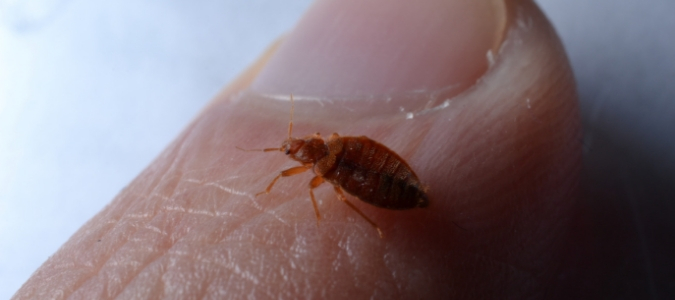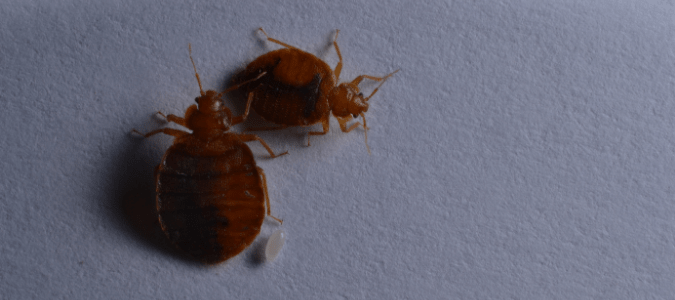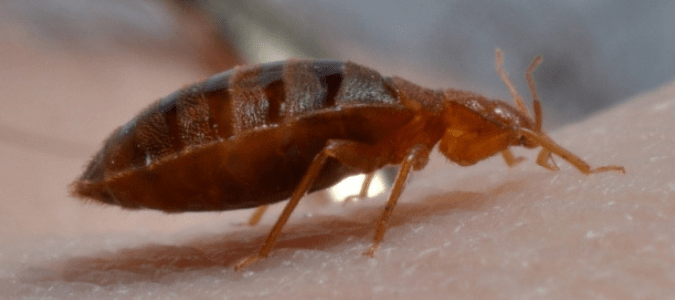So you’ve woken up covered in itchy, red bites. Or maybe you simply have suspicious-looking red spots on your skin that aren’t itchy—yet. Could you have a bed bug problem? Most people live in fear of bed bugs, which is understandable. Once they infest an area, these pests are notoriously hard to eliminate. Learning how to know if you have bed bugs will help you determine what’s going on. Then, if you do have a bed bug problem, you can decide on the best way to get rid of them.
The first sign of bed bugs that most people notice is small, red, itchy bites on the skin. These bites typically show up in the morning, since bed bugs are nocturnal. This means they are most active at night, under the cover of darkness. Bed bugs feed on the blood of humans and other animals. They take advantage of our nighttime sleep habits to bite us undisturbed.
For most people, bed bug bites are intensely itchy, though they may not itch at first. The bites might cause red welts or even small blisters on the skin. They may also be grouped together in a line. Some people call this a telltale breakfast, lunch and dinner pattern, since it results from these pests’ habit of biting a person, feeding on their blood for a minute or two, and then moving a few millimeters away to bite them in a new spot.
Bed bugs will bite people anywhere they can reach on the skin, which means any skin that is uncovered at night. Their bites are not the only sign of bed bugs, however.
Signs of Bed Bugs
If you suspect you may have an infestation, there are other signs you can look out for:
- Carefully inspect your pillows and mattress for brown or rust-colored blood spots, shed bed bug casings or bed bugs themselves. Adult bed bugs are small, reddish-brown in color, and oval-shaped. They have six legs, two antennae, and no wings. They are about the size, shape and color of apple seeds. Bed bug nymphs, or babies, look like much smaller, paler versions of the adults.
- Look especially closely at the seams that run along the edge of the mattress. Bed bugs tend to hide in these tiny crevices during the day. They also lay their eggs in these protected spots. Bed bug eggs are tiny, yellowish or milky white in color, and slightly translucent. They are hard to see with the naked eye. Some people wrap tape, sticky side out, around a credit card and press it into the seams of the mattress. Then, they see if they can pull out any bed bug eggs, nymphs or adult bed bugs.
- Despite their name, these pests can also infest other furniture and areas of the house besides the bedroom. Sometimes they hide out in cracks in the bed frame or between floorboards below the bed. They might also hide out in dresser drawers, on the wall next to the bed, or even behind wall hangings. Look closely all around the bed area for evidence of bed bugs. It’s also a good idea to look closely at your sofa or any other furniture where people sleep or spend lots of time.
For many people, the best way to deal with a potential bed bug infestation is to hire a pest management specialist. A specialist can make a thorough inspection of the entire home. A professional knows all the signs of bed bug activity to look for, and where to look for them. Once they determine whether you have bed bugs or some other type of pest, like fleas or mosquitoes, they can recommend a pest treatment plan that is tailored to your home and the people and pets that live there.
Bed Bug Life Cycle
One of the main reasons why these pests are such a difficult problem to treat is how quickly bed bugs reproduce. A single female bed bug can lay up to about 250 eggs within her lifetime! If you go on a trip and unknowingly bring these pests home in your suitcase, just a few could turn into a major, widespread problem in your home over time. Let’s take a closer look at the bed bug life cycle to better understand exactly what you’re up against if you are dealing with an infestation.
- The egg: Like most insect pests, bed bugs go through multiple stages through the course of their life cycle. First, there is the egg—very small, oblong, slightly translucent, and milky white or yellowish in color. Bed bug eggs are only about a millimeter long, and female bed bugs lay them in tiny crevices and other tight spaces. Since they are pale in color, they can be hard to see without the help of a flashlight and a magnifying glass.
- The nymph: Bed bug eggs hatch into nymphs—tiny bed bug babies—within about two weeks. These wee pests look like much smaller, paler versions of adult bed bugs. They will molt, or shed their skins while growing, five times before developing into full-fledged adults. Each time they molt, they need a blood meal to reach the next stage of maturity.
- The adult: After about five weeks (at normal room temperature), a bed bug nymph completes its final molt and becomes an adult bed bug. At this point, this pest is reddish-brown, flat, oval-shaped, and about a quarter of an inch long. Adult bed bugs need a blood meal about once a week.
The entire lifespan of a bed bug, from egg through mature adulthood, is about six months. Strangely enough, these pests can live even longer without food, especially in cooler temperatures. This is another reason why bed bugs are so hard to get rid of. They can live a long time, lying in wait for another blood meal to come their way.
Most people pick up bed bugs while traveling. They might unknowingly stay in a hotel room with a bed bug infestation, and then bring the pests back home with them. Since bed bugs can survive for months in cool areas without a blood meal, even homes or hotel rooms that haven’t been in use for a while might have bed bugs that are waiting to feed on your blood while you sleep at night.
This is why it’s very important to make a careful inspection of your room whenever you travel. Pull back the sheets to take a close look at the mattress and pillows. Look carefully inside bureau drawers before using them. Better yet, hang your clothes in the closet, and store your suitcase on a luggage rack instead of on the floor.
When you return home, wash all your clothes in very hot water and dry them on your dryer’s hottest setting before putting them away again. If possible, you can also set your empty suitcase outside for a few days, since sunlight and heat can kill off bed bugs. Another alternative is to store your suitcase inside a sealed garbage bag, in case any bed bugs are hiding inside.
These measures should help you avoid bringing home unwanted hitchhiker pests after traveling. But if you do wind up bringing bed bugs home, your best bet is to hire a professional to inspect your home and recommend a pest treatment plan.
What Smells Do Bed Bugs Hate?
If you’re waking up itchy in the mornings from bed bug bites, you might be willing to try anything to get rid of these pests. What smells do bed bugs hate? Are there certain smells that repel them? Pest management specialists get questions like these a lot. Unfortunately, while there are certain smells that bed bugs seem to dislike, they aren’t very effective at keeping these pests under control in the case of an infestation.
It would certainly be wonderful if there were smells that did a great job of repelling bed bugs. You could spritz your bed and dresser with the scent, and then sleep soundly knowing you wouldn’t be bitten. Some people do report that bed bugs seem to dislike essential oils with spicy scents, like peppermint, spearmint, tea tree and cinnamon.
If you don’t mind the strong, sharp scent of these oils, there is no harm in seeing if using them in your bedroom might repel pests. Do be aware, however, that many of these same oils can be poisonous for pets. If you have dogs or cats, be very careful to keep essential oils well away from them.
Blood orange oil is another essential oil with a scent that is reputed to repel bed bugs. The scent of lemon juice and black pepper are also supposed to repel them. The truth is, though, these supposedly natural, do-it-yourself methods may actually be unsafe, and are likely to be ineffective. This is especially true if you’re dealing with a heavy bed bug infestation.
The best way to get rid of bed bugs is to hire a reputable pest control professional. A pro will use proven methods to get your bed bug problem under control, so the whole family can be comfortable.
ABC Can Eliminate the Bed Bugs in Your Home
Contacting a professional for bed bug control is imperative. If you’re dealing with these pests, contact ABC Home & Commercial Services. We will create a custom pest treatment plan that best fits your needs.


